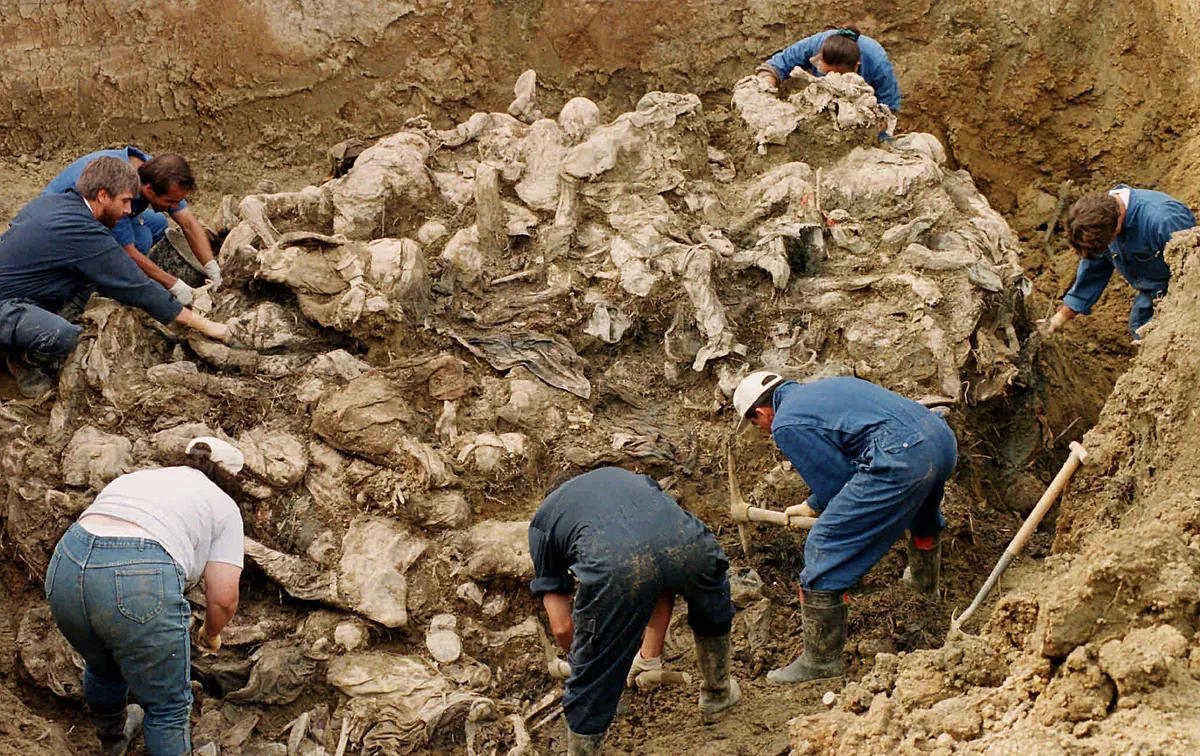It is hard to fathom that so much hatred could exist to kill 8,000 people with the sole purpose of making an entire people disappear. Srebrenica may be a blurry memory from 30 years ago in a remote place in Europe, at the end of the three and a half years of the war in Bosnia and Herzegovina. But survivors like Sadik Selimovic, who lost his father and three brothers, remind us through their daily lives of that massacre, beyond the annual commemoration events.
As a researcher at the Institute for Missing Persons in Bosnia, he has the vital mission of finding more mass graves and the remains of some of the 1,000 people still missing three decades later. "In the last three years, we have identified 62 sites, but we have not found a single body," Selimovic recounts in an interview with AFP. The last mass grave was located in 2021, where the remains of 10 victims were exhumed.
Over the years, Selimovic found the bodies of his four family members, the last being his younger brother, Sabahudin, whom he was able to bury two years ago. But at 62 years old, he wants to continue the task of searching for others without being burdened by time and forgetfulness: "It's what keeps me alive. I know what it's like to be told they found your loved one," he shares in the same interview.
On this anniversary, seven victims who have been identified will be buried at the Srebrenica-Potocari Memorial Center. Among them are the identified remains of Mirzeta Karic's father, Sejdalija Alic, of whom only the lower jaw remains. The family does not want to wait any longer to bid him a final farewell: "My mother is very ill and wants it to be done," she tells the French agency. Her brother Senad, who was killed at 17, was never found.
That July 11 is marked as the date - although the massacre lasted several days - when the Serb forces, led by General Ratko Mladic, the so-called Balkan Butcher, and the Serb leader Radovan Karadzic, shot and killed 8,000 Muslim men and boys from the enclave they had just conquered, which was under the protection of the UN. The town housed over 40,000 people, many of whom were displaced by the Bosnian war. Both Karadzic, now 80, and Mladic, 83, are serving life sentences for genocide and war crimes, a sentence handed down by the International Criminal Tribunal for the former Yugoslavia in The Hague.
The International Commission on Missing Persons (ICMP), based in The Hague with a laboratory in Srebrenica, is responsible for identifying the bodies. This organization recalls how on that July 11, faced with the Serb threat, thousands of men and boys left the town to head towards Tuzla. Along the way, they were detained and executed. Those who delayed leaving were killed in Srebrenica itself.
Forensic anthropologist Dragana Vucetic, who has been working for the ICMP for 20 years, tells AFP that in their morgue and in the Bosnian Commission for Missing Persons in Tuzla, there are still remains of "90 cases whose genetic trace (DNA) has been isolated" but have not yet been identified. There are also about 50 victims who have been identified. "But families still refuse to validate the identification and give them a burial. Most of the time because the bone remains are incomplete."
She explains that initially, the bodies were thrown into large mass graves near the "five sites of mass execution". "A few months later, these graves were opened, and the bodies, already in the early stages of decomposition, were transported to other locations, sometimes 100 kilometers away," explains the doctor.
There, the bodies were "dismembered" by bulldozers and excavators and transported to two or three different locations to conceal the crime. "During the exhumations, we only find complete bodies in 10% of cases," explains the anthropologist. DNA tests were used to reconstruct some skeletons, parts of which were sometimes found in four mass graves. Around 6,000 people were identified between 2012 and 2022, after which the number of identifications has been decreasing, with only three cases since early 2025.
Adnan Cerimagic was nine years old when the genocide was committed. This Bosnian analyst from the European Stability Initiative think tank recalls that the massacre was not usually discussed in schools, and when it was, "it was presented in ways that reflected ethnic divisions." "There is still no curriculum accepted by the entire state to describe what happened. Although the Srebrenica Memorial Center and a group of History teachers in Bosnia and Herzegovina have made some attempts," he points out.
"The Srebrenica genocide is not just a painful memory, but a test for the country's future," explains this expert who believes that the wound has not yet healed even though 30 years have passed. Especially when "denial of the genocide is still widespread among some political leaders," he says referring to the political leaders of the Serb entity (Republika Srpska) and Serbia. For him, "it symbolizes the consequences of extreme nationalism and the failure of the international community to protect civilians."
"The way Bosnia faces Srebrenica defines whether it can progress as a democratic society based on truth, justice, and the rule of law," he opines. "Remembering Srebrenica is not just about the past but about rejecting hatred and division now, and insisting on a common and honest understanding of history as a basis for peaceful coexistence," he adds about the dangers of forgetting.
